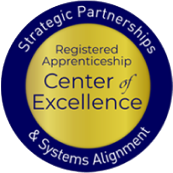| Body | Resource Date | Resource Link |
|---|---|---|
Employers across diverse industries are increasingly utilizing Registered Apprenticeship (RA) programs to meet critical workforce demands. Accelerating adoption of RA requires that employers can access the full spectrum of funding support. State and local workforce development boards (WDBs) can play a crucial role in meeting employers’ needs and supporting the expansion of RA nationwide with strategic use of both Workforce Innovation and Opportunity Act (WIOA) and non-WIOA funds. This tool is designed to provide local WDB leadership and staff with knowledge and tools to leverage, or “braid,” a wide array of funding sources to support local employers in growing sustainable RA programs. |
https://dolcoe.safalapps.com/sites/default/files/2025-09/Braiding%20Funds%20to%… | |
The Center of Excellence developed this practical guide to help businesses understand, engage with, and form effective partnerships with apprenticeship intermediaries. The guide explains what intermediaries are, outlines the various types (including national, regional, and youth-focused organizations), and highlights the key roles they can play—such as conveners, technical assistance providers, or program sponsors. It features real-world examples, readiness checklists to evaluate your company's preparedness, and actionable tips for selecting the right partner. The guide is ideal for employers looking to launch, grow, or improve existing Registered Apprenticeship programs with expert support. |
https://dolcoe.safalapps.com/sites/default/files/2025-09/Employer%20Guide%20for… | |
This two-page guide outlines how employers can benefit by collaborating with Local Workforce Development Boards (LWDBs) to establish or expand Registered Apprenticeship (RA) programs. It highlights several employer challenges such as sourcing qualified talent, accessing training providers, covering Related Instruction (RI) costs, and navigating labor market data, and shows how LWDBs can help address each. Key resources include candidate screening and recruitment, pre-apprenticeship training, leveraging WIOA-approved education/training providers, funding support, and connecting to community partners. This guide is designed to help employers understand the tangible advantages of such partnerships and how they make apprenticeship programs more effective, affordable, and sustainable. |
https://dolcoe.safalapps.com/sites/default/files/2025-09/Value%20of%20Employers… | |
This resource equips American Job Center (AJC) case managers with clear tools, strategies, and resources to help veterans transition successfully into Registered Apprenticeship (RA) programs. It covers everything from intake and priority-of-service under WIOA, military skills assessment, and collaborating with Veteran-specific programs, to understanding how to verify VA-approved RA providers and ensure veterans receive all eligible benefits such as the GI Bill’s housing allowance. Case managers will find actionable steps to strengthen employer partnerships, guide veterans in developing career plans, and improve employment outcomes through Registered Apprenticeship pathways. |
https://dolcoe.safalapps.com/sites/default/files/2025-09/Bridging%20the%20Gap%2… | |
This resource outlines and describes the key components of workforce system alignment with Registered Apprenticeship (RA). The document highlights six strategies for strengthening system alignment: adopting supportive policies that prioritize apprenticeship and streamline funding; embedding RA experts in American Job Centers to guide staff and job seekers; training Business Services Representatives to promote programs and engage employers; aligning data systems to improve sharing and policymaking; convening employers, educators, and partners to drive sector-based expansion; and, in some cases, having workforce boards or agencies directly sponsor apprenticeship programs to accelerate adoption and create more career pathways. |
https://dolcoe.safalapps.com/sites/default/files/2025-09/DOL%20RA%20TA%20COE%20… | |
Chamber of Commerce members are employers who all share on common ongoing needs core to their business success: attracting, recruiting, hiring, training, and upskilling workers. This Guide outlines the core components of Registered Apprenticeship, explains its benefits for chambers and member businesses, and provides actionable strategies for chambers to become active facilitators in their regions. It includes real-world case studies from Chambers across the country—including the Charleston, South Carolina Metro Chamber of Commerce, the Greater Cleveland Partnership, the Kentucky Chamber Foundation, and the German American Chamber of Commerce—to highlight successful approaches and scalable practices. The document concludes with practical next steps to help Chambers assess their members’ workforce development needs, align with apprenticeship systems, and create strategic partnerships that maximize impact. Through these efforts, Chambers can expand their role as vital workforce development leaders. |
https://dolcoe.safalapps.com/sites/default/files/2025-08/RA%20and%20Your%20Cham… | |
This guide is intended to be a starting point to help state and local workforce professionals understand the key players in the apprenticeship space, what role(s) those partners typically play in supporting registered apprenticeship programs, and how you can play a leadership role in creating registered apprenticeship partnerships that engage those entities. |
||
Use this resource to align your Integrated Education and Training (IET) programs with pre-apprenticeship and Registered Apprenticeship (RA). This resource is aligned to the IET design toolkit, and whether you are developing an IET program with pre-apprenticeship or RA in mind or want to align your current IET programs, this resource will help to support a direct pathway into a pre-apprenticeship and RA. |
||
This questionnaire is intended to help your organization answer important internal questions in preparation for working with your local US Department of Labor Office of Apprenticeship (DOL OA) staff or State Apprenticeship Agency (SAA) staff to develop or expand a registered apprenticeship (RA) program. |
||
This guide is intended to be a starting point to help state and local workforce professionals understand the key players in the apprenticeship space, what role(s) those partners typically play in supporting RA programs, and how you can play a leadership role in creating RA partnerships that engage those entities. |
https://dolcoe.safalapps.com/sites/default/files/2025-07/Workforce%20Board%20Gu… |
